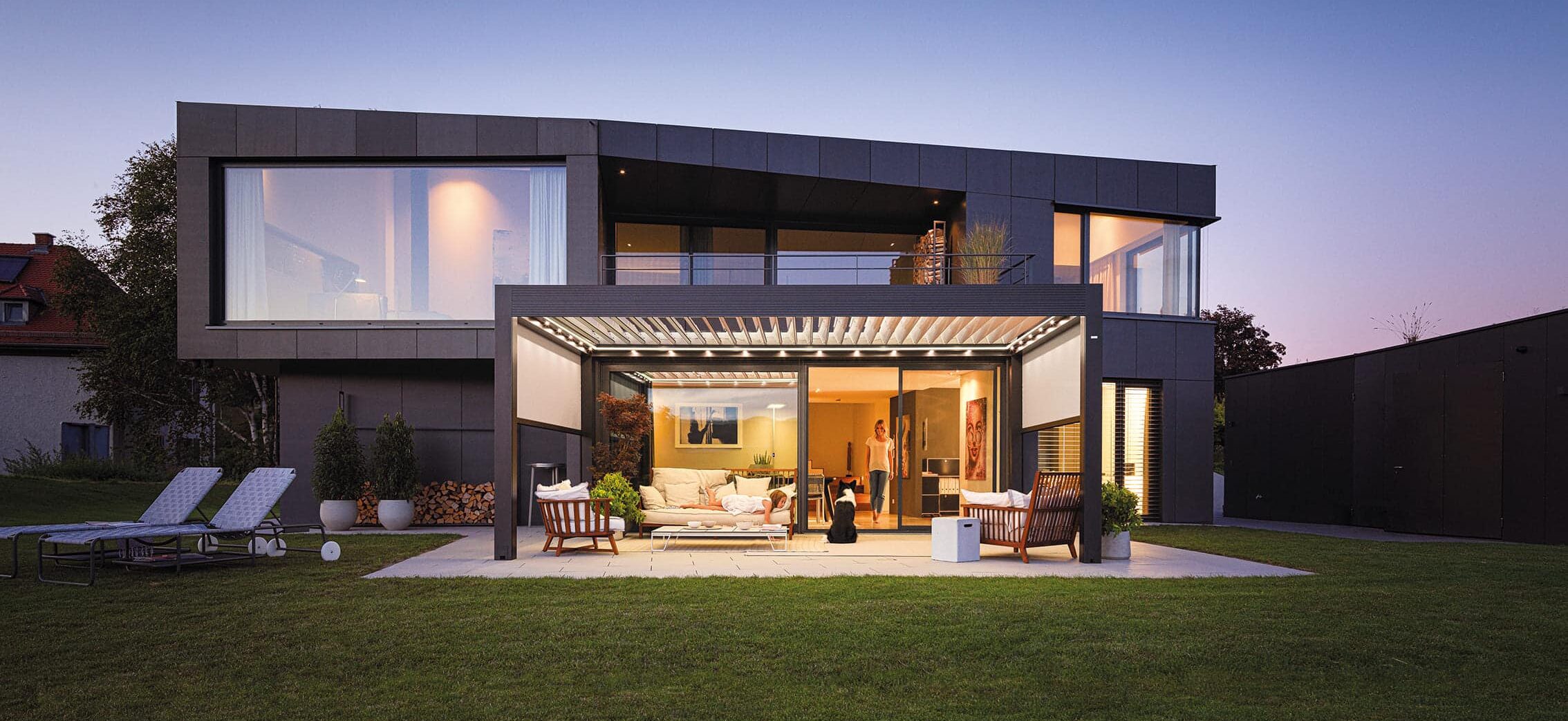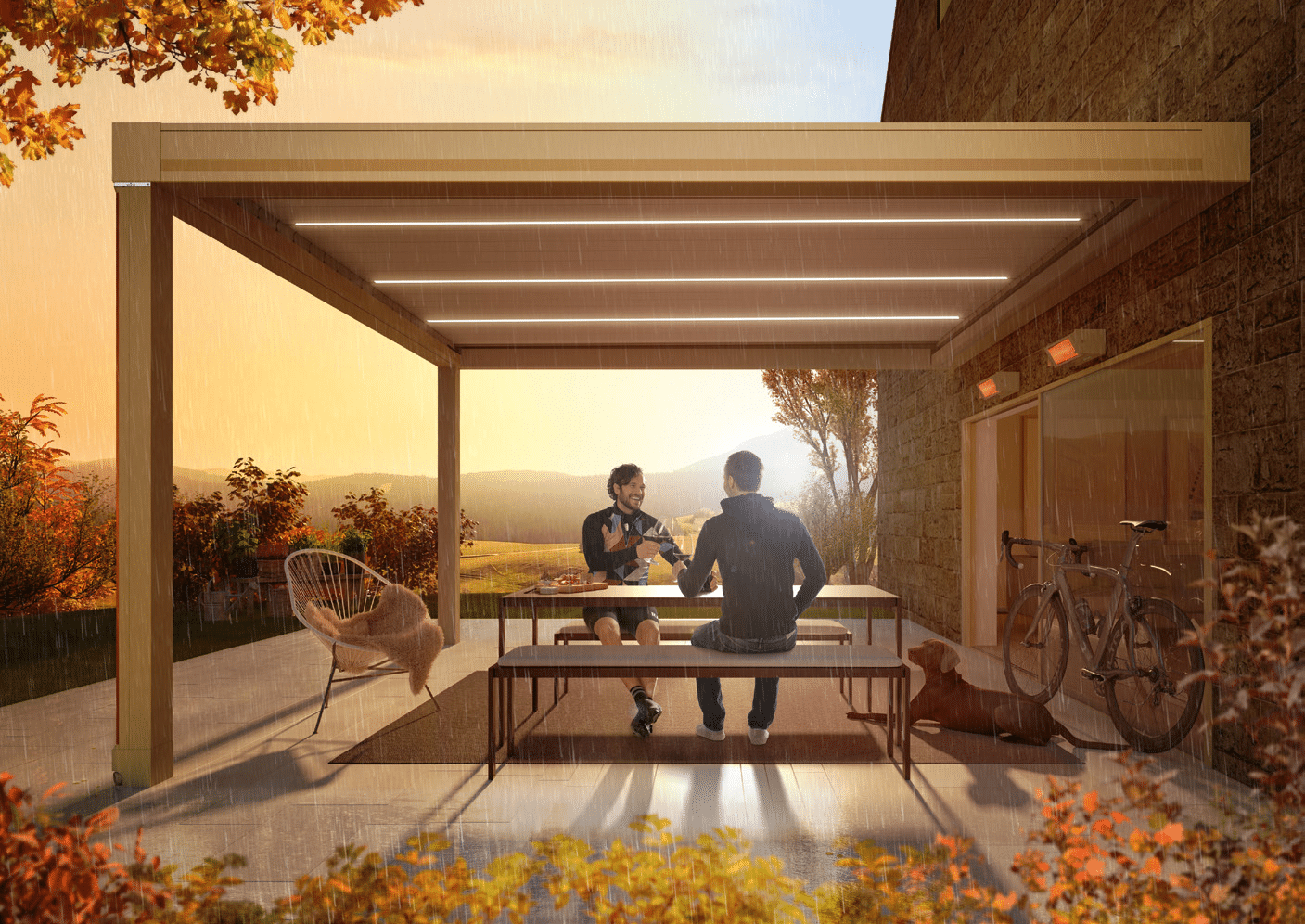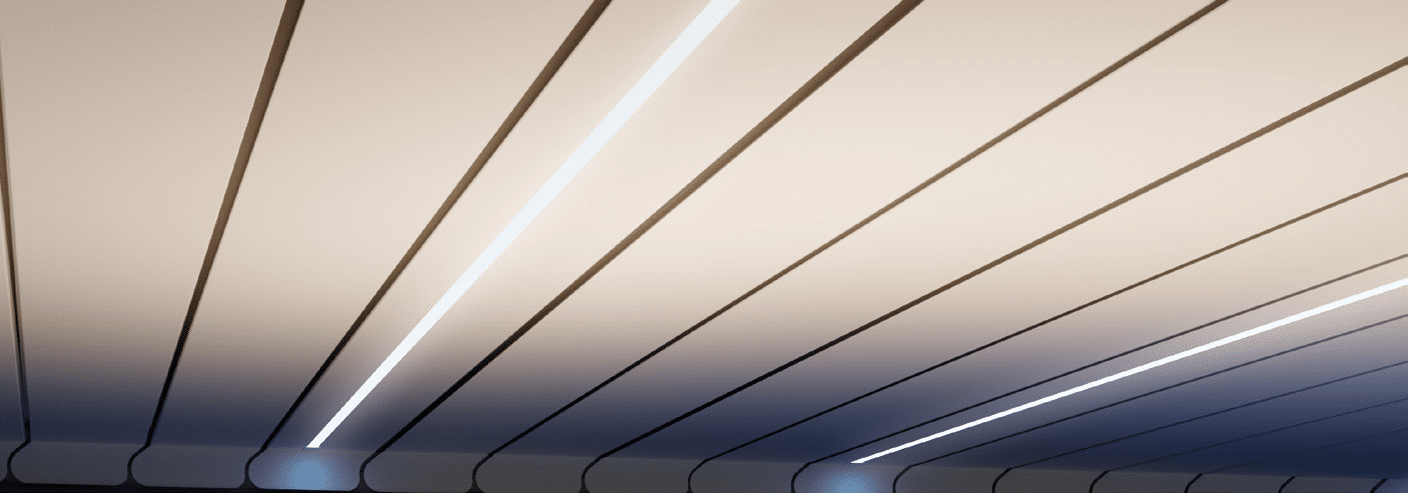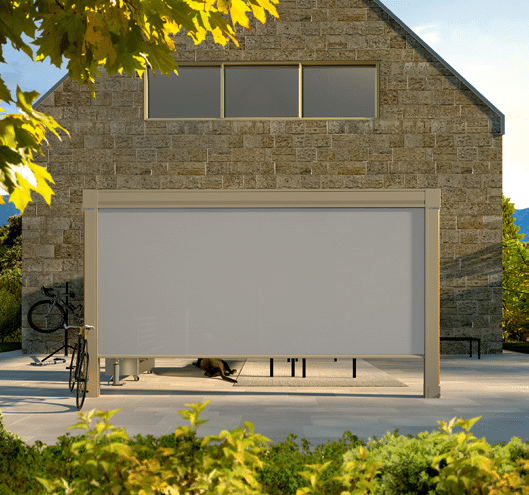Sunshade Roofs
Book a free survey
The emergence of sunshade roofs has reshaped how we perceive outdoor spaces, serving as a testament to how modern design can seamlessly blend functionality with aesthetics. Sunshade roofs aren’t just about providing shelter from the sun; they symbolise a broader architectural movement that emphasises user comfort and stylistic innovation. They are sophisticated structures designed to extend living spaces, provide comfort, and elevate the look of any building.
Historically, the primary objective of outdoor roofs was to offer protection against elements like rain or sun. However, as architectural designs evolved and homeowner needs became more intricate, the role of these structures started to shift. Today’s sunshade roofs are multifaceted, catering not only to the functional requirements but also aligning with the aesthetic aspirations of homeowners and architects alike.
The popularity of sunshade roofs underscores a broader trend in modern architecture and design: a desire for beautiful and utilitarian spaces. This shift has led to the creation of dynamic outdoor spaces that serve as extensions of the interior, providing a harmonious transition that enhances both the form and function of a building.

Sunshade roofs are more than just architectural marvels; they’re rooted deeply in science. Beyond aesthetic appeal, the primary aim is to optimise comfort by moderating the direct impact of sunlight, reducing heat gain, and ensuring adequate ventilation. The design and orientation of a sunshade play a crucial role in determining its effectiveness in these areas.

The angle and spacing of sunshade louvers or panels are meticulously calculated to block the high-angle summer sun while allowing the low-angle winter sun to penetrate. This approach helps in naturally regulating indoor temperatures, making spaces cooler in the summer and warmer in the winter. The strategic design reduces the reliance on artificial cooling or heating systems, leading to energy savings.
Furthermore, the materials used in sunshade roofs also contribute to the science of comfort. Reflective materials can repel significant sunlight, further reducing heat gain. On the other hand, permeable materials can facilitate ventilation, ensuring a constant flow of fresh air. The science behind sunshade roofs is a delicate balance of physics, material science, and architectural design, all coming together to create comfortable spaces.
The choice of materials for a sunshade roof is pivotal, impacting everything from its durability to its effectiveness in providing shade. Traditionally, materials like wood and metal have been popular choices. While wood offers a natural and timeless aesthetic, metals like aluminium and steel boast strength and longevity. However, with advances in material science, a plethora of new options have emerged, each bringing its own set of advantages.
For those seeking a blend of strength and aesthetics, composites like fibreglass are becoming increasingly popular. These materials are robust and durable and offer a degree of flexibility in design. Meanwhile, for those prioritising sustainability, materials like bamboo or recycled plastics present an eco-friendly alternative without compromising on style or function.
In the realm of high-tech solutions, there are materials that change opacity based on sunlight exposure or can even harness solar energy while providing shade. The key is to understand a project’s specific needs and constraints and then match them with the right material. Whether it’s prioritising longevity, aesthetics, eco-friendliness, or innovative features, the current market offers a material to suit every need.
Sunshade roofs have become synonymous with innovative installations in contemporary architecture. As architectural forms have evolved, so has the integration of these shading devices. Today, they’re not just supplementary add-ons but are often central to a building’s design narrative. Sunshade roofs can make a striking statement, whether it’s a residential space or a large commercial complex.
In residential architecture, sunshade roofs can redefine patios, balconies, and terraces, making them more usable throughout the year. The design possibilities are endless: from minimalist straight-line designs that complement modern homes to intricate patterns that can become the focal point of a space.
Sunshade roofs can provide a functional yet aesthetically pleasing solution for commercial spaces. Be it a restaurant looking to provide its patrons with a comfortable outdoor dining experience or an office building aiming to reduce its energy consumption, sunshade roofs can cater to a wide range of needs. With the right design and material choices, these installations can elevate the architectural identity of a space, making it stand out and resonate with its occupants.
While the primary function of sunshade roofs is to provide protection from direct sunlight, their benefits extend far beyond just shade. One of the most significant advantages is energy savings. Sunshade roofs can effectively lower indoor temperatures by reducing the amount of direct sunlight entering a space. This natural cooling effect reduces the dependency on air conditioning, leading to substantial energy savings and reduced utility bills.
Another often overlooked benefit is the enhancement of privacy. Sunshade roofs, especially those with adjustable louvers or panels, can be angled to prevent direct views into a space. This feature is particularly useful for urban settings, where buildings are closely spaced and privacy can be a concern.
Additionally, sunshade roofs can prevent the fading of furniture and floorings by mitigating direct sunlight, thus extending their lifespan. They also provide protection against elements like rain when designed with water-resistant materials or incorporated drainage systems. In essence, while the primary function of these structures is to shade, their benefits encompass a broader range of comfort, savings, and privacy enhancements.

When it comes to sunshade roofs, design isn’t just about aesthetics but functionality. A well-designed sunshade roof should strike a balance between providing shade, allowing natural light, and ensuring proper ventilation. Achieving this harmony requires careful consideration of various factors like the sun’s path, prevailing winds, and the specific requirements of a space.
Orientation is crucial. A sunshade roof designed for a space that faces the west would differ significantly from one facing the north. While the former would need to combat the intense evening sun, the latter would focus more on maximising natural light. The angle and spacing of louvers or panels play a pivotal role in this balancing act.
Ventilation is another crucial aspect. While blocking out the sun is essential, it shouldn’t come at the cost of stifling a space. The design should ensure a consistent flow of fresh air, preventing the buildup of heat. This can be achieved through strategic gaps or using permeable materials. Designing a sunshade roof is a meticulous process that requires a deep understanding of the environment, user needs, and architectural nuances.

The world of smart homes has brought a paradigm shift in how we interact with our living spaces. This digital revolution has not spared sunshade roofs, which are now being seamlessly integrated into smart home systems. Imagine adjusting your sunshade roof with a voice command or having it automatically adapt to weather conditions; this is the future of sunshade experiences.
Integrating sunshade roofs with home automation systems provides a level of convenience that was previously unthinkable. Sensors can detect changes in weather conditions, automatically adjusting the angle of the sunshade or retracting it entirely during adverse conditions. Integration with smart lighting systems can ensure optimal indoor lighting, adjusting the shade and artificial lights in tandem.
Another significant advantage is energy conservation. Smart sunshade roofs can work in conjunction with heating, ventilation, and air conditioning (HVAC) systems. By regulating the amount of sunlight entering a space, they can reduce the load on air conditioners or heaters, leading to energy savings. In a world where every device is interconnected, the seamless integration of sunshade roofs into the smart home ecosystem represents the pinnacle of modern living.
In an era where sustainability is at the forefront of architectural and design discussions, sunshade roofs are emerging as a critical component of green building practices. These structures promote energy efficiency by their very nature, but their environmental impact goes beyond just energy savings.
Sunshade roofs reduce indoor temperatures naturally and reduce the need for artificial cooling. This reduced dependency on air conditioning systems translates to lower carbon emissions, playing a part in combating global warming. Furthermore, by facilitating natural lighting, they can reduce the need for artificial lighting during the day, further conserving energy.
The choice of materials can also contribute to the environmental credentials of sunshade roofs. Using sustainable or recycled materials can reduce the carbon footprint of the structure. Moreover, some innovative designs incorporate features like green roofs, integrating vegetation within the sunshade structure, promoting biodiversity, and offering natural insulation. When designed with sustainability in mind, sunshade roofs can be a testament to eco-friendly architectural practices.
We provide a free consultation and onsite 3D visual design to ensure you are completely satisfied prior to confirming your order. Over the years we’ve perfected a three-step process we apply to all installations.

Sed molestie ornare neque in ultricies. Cras sit amet congue nisl. Orci varius natoque penatibus et magnis dis parturient montes, nascetur ridiculus mus.

Martyn, from 'The Outdoor living group' has been fantastic in providing us with the most wonderful veranda with a glass roof and sunshade. It arrived as arranged on 17th March 2020. We were fortunate as this was just before 'lockdown' and we have used it everyday since then to eat outside in this wonderful weather. It helps to keep the wind out and feels warmer than just sitting out. The sunshade has been great on those warmer days. I would definitely recommend the company to you.
We had our glass veranda with electric sunshades installed in May 2021 by The Outdoor Living Group and we are absolutely delighted with it! Martyn and his team were great. The whole process was seamlessly organised and we were kept informed from beginning to end. We were particularly impressed with the extremely comprehensive and detailed site visit and this helped to reassure us that we were making the right decision and that the project would be a success.
Our finished glass room has exceeded all our expectations. Martyn’s advice and suggestions about colours and style proved to be spot on and so in keeping with our house. His attention to detail ensured the team we had already hired to do our landscaping and patio knew exactly what they had to do, avoiding any problems later. The installers were extremely professional, skilled and polite and completed the job so efficiently. Due to Covid related supply issues there one or two very slight pr...
Very happy with Martyn and his team. From the initial consultation and competitive quote to completion was a refreshingly pleasant experience. Martyn came up with a couple of ideas that made a difference to our first plans, and we are very pleased with the result, giving us a room we use all year round. Installation team were very easy to deal with and took pride in their workmanship.